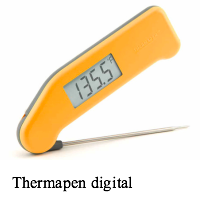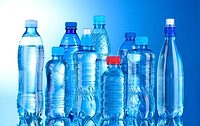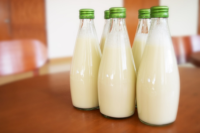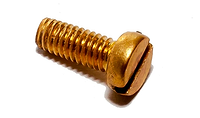One of the most important things we can do as food safety professionals is to ensure that our instruments provide accurate and precise measurements. Still, questions swirl every time I mention thermometer calibration at a food safety training.
How often should I conduct accuracy checks? Does every thermometer have to be calibrated? What is the National Institute of Standards and Technology (NIST)?
I wished there was a one-stop resource where food safety professionals could answer these questions in plain language. Then I stopped wishing, picked up the phone, and called Kyle Halvorson at ThermoWorks, the temperature professionals.
Charlie Kalish, Food Safety Guides (CK): Hi, Kyle. Thanks for taking the time to answer my questions.
KH: It’s my pleasure. Here at ThermoWorks, our passion is temperature—and the tools we use to measure temperature—so the topic is perfect for us.
.png)
CK: OK. Most quality assurance (QA) professionals know that thermometers need to be recalibrated at least annually. Why is that? What causes thermometers to drift?
KH: The answer to your question is determined by the type of thermometer that you are talking about. With dial thermometers, the sensor actually expands and contracts to move the needle. Repeated expansion and contraction over time causes the metals to lose some of their elasticity. They can also fall out of calibration just by dropping them on the counter or banging them around in a drawer. These are some of the reasons why dial thermometers need frequent verification. If you still use dial thermometers, they should be checked daily—weekly at the very least.
Digital thermometers, on the other hand, utilize sophisticated electronic circuitry and microprocessors to perform very precise measurements and complex calculations on a variety of sensor types. A high-quality digital thermometer is far less likely to drift through normal use because the electronics and sensors are quite rugged when packaged for such use. Drifting is more often the result of physical or liquid damage to the device. 
Regularly scheduled calibration services by an accredited, third-party lab are a best practice. The calibration certificate issued upon completion of this service is an assurance that your device is reading properly. The calibration certificate will contain actual test data showing you what temperature points your thermometer was tested at and what your thermometer read at those temperatures.
CK: What is NIST and why is it important for U.S. food facilities?
KH: NIST is a non-regulatory federal agency within the U.S. Department of Commerce. Simply stated, NIST is responsible for developing and maintaining standards for most measurements used in everyday life such as temperature, time, weight, volume, and many others.
CK: What does it mean for a thermometer to be “NIST-traceable?”
 KH: A thermometer is considered "NIST-traceable" when it’s calibration can be traced back to a measurement standard held at NIST through a documentation trail. It rarely means that NIST itself performed a specific calibration service. Take, for example, a standard Thermapen. We calibrate that Thermapen by comparing it to a reference thermometer in our accredited lab. That reference thermometer was calibrated by comparing it to a very accurate standard thermometer. The standard thermometer was calibrated for accuracy at NIST. Each of these calibrations is accompanied by a certificate that includes the accuracy of the comparison. As a result, we can determine the accuracy of the Thermapen and say it is “NIST-traceable."
KH: A thermometer is considered "NIST-traceable" when it’s calibration can be traced back to a measurement standard held at NIST through a documentation trail. It rarely means that NIST itself performed a specific calibration service. Take, for example, a standard Thermapen. We calibrate that Thermapen by comparing it to a reference thermometer in our accredited lab. That reference thermometer was calibrated by comparing it to a very accurate standard thermometer. The standard thermometer was calibrated for accuracy at NIST. Each of these calibrations is accompanied by a certificate that includes the accuracy of the comparison. As a result, we can determine the accuracy of the Thermapen and say it is “NIST-traceable."
CK: Can you please explain the difference between calibration and checking for accuracy?
KH: The international definition for calibration is essentially the act of comparing an unknown to a known, noting the difference, and applying a correction mathematically. No adjustments are attempted to bring them into agreement. One of the reasons for this approach is that the reference standards at the very top of the calibration chain are nonadjustable devices—so calibration had to be defined this way.
In practice, however, checking for accuracy is generally considered a less rigorous exercise used to verify that a calibrated device is still good to use. Many industries require users to check accuracy in between formal calibrations. If you fall into this category, you can quickly prepare an ice bath (see our video) to check it for accuracy. This check does not constitute a calibration service. A calibration service would require multiple checks at several temperatures, adjustments to remove the errors in the device being calibrated, and a final full set of data to show that the calibration was successful. And again, accredited labs—like the A2LA-accredited calibration lab on-site here at ThermoWorks—provide much greater assurance of accuracy than NIST-traceable certificates alone.
CK: If a thermometer is calibrated, comes with a certificate certifying the thermometer is calibrated for up to 1 year, why do we need to check a thermometer for accuracy during that time period?
KH: The certification of accuracy that comes with an instrument is only completely valid for the time and day that the instrument was calibrated. The 1-year term is based on an expectation that under “normal usage conditions” this particular instrument should continue reading within its accuracy specification for a full year. But you never know when some event—a physical shock, for example, or exposure to extreme temperatures—may change the orientation of the instrument and affect its accuracy. Performing routine accuracy checks on your own is a way for you to mitigate the risk that your instrument could go out of spec before the full year of the certificate is up. If you determine that one of your thermometers is out of its accuracy specification at the ice point or the boiling water point, it’s time to send the thermometer in for calibration before the full 1-year term is up.
CK: What are common, valid methods used in the food industry for checking a thermometer’s accuracy?
KH: One of the most convenient ways to check the accuracy of a thermometer is with a properly prepared ice bath test. The ice bath test is a standard laboratory test that is most easily replicated and is not subject to variables such as elevation and atmospheric pressure. A properly prepared ice bath can produce temperatures of 32 °F or 0 °C, within 0.1 °F (0.05 °C). (see our video)
Another commonly used method for checking accuracy is boiling water. In order to perform this test properly, you will need to first calculate the boiling point of water in your area based on elevation and atmospheric pressure, which can change slightly from day to day. You can then compare your thermometer to your calculated boiling point in a pot of water at a full, rolling boil. If you choose this method, feel free to use our boiling point calculator.
We also have block calibrators available that can hold a stable temperature for calibrating.
CK: What factors determine how often we check a thermometer’s accuracy?
KH: Several nontime related factors have shown to be more critical in determining calibration intervals. These factors include the frequency of use, the application in question, the type of sensor being used, the range of temperatures being measured, as well as the level of care taken during use, handling, and storage.
For example, a company or individual that uses the thermometer on a daily basis, shares instruments between users, operates in a harsh environment, or uses an instrument roughly (i.e. drops the instrument, fails to take care with the probe, or routinely tosses the instrument into a toolbox or container for storage) may require a shorter calibration interval.
CK: There are regulatory considerations, too. The company may be required to conduct accuracy checks at certain intervals to provide the necessary level of assurance that the measurements are valid. Likewise, if someone wants to check their thermometer for accuracy once a month, they run the risk of having to recall product if a check indicates the thermometer is no longer accurate, calling into question all of the measurements collected since the last good check.
KH: Yes, you bring up an excellent point. The more frequently you check your thermometers, the less risk you are exposing yourself to.
CK: Thank you for speaking with me!
KH: You bet. And tell your readers that if they have any further questions about any of these topics, they can always call me or one of the other temperature specialists here at ThermoWorks. If they are in need of calibration services, they can reach out to us on the web or at 800.393.6434.
ThermoWorks provides thermometers and related products to food processing plants, farming operations, grocery stores, restaurants, and other businesses across the food supply chain to ensure that dairy, produce, meat, seafood, and poultry remain at safe temperatures.
Charlie Kalish is the cofounder of Food Safety Guides, a U.S.-based food safety consulting and training firm that specializes in U.S. regulatory compliance and food safety plan development.




